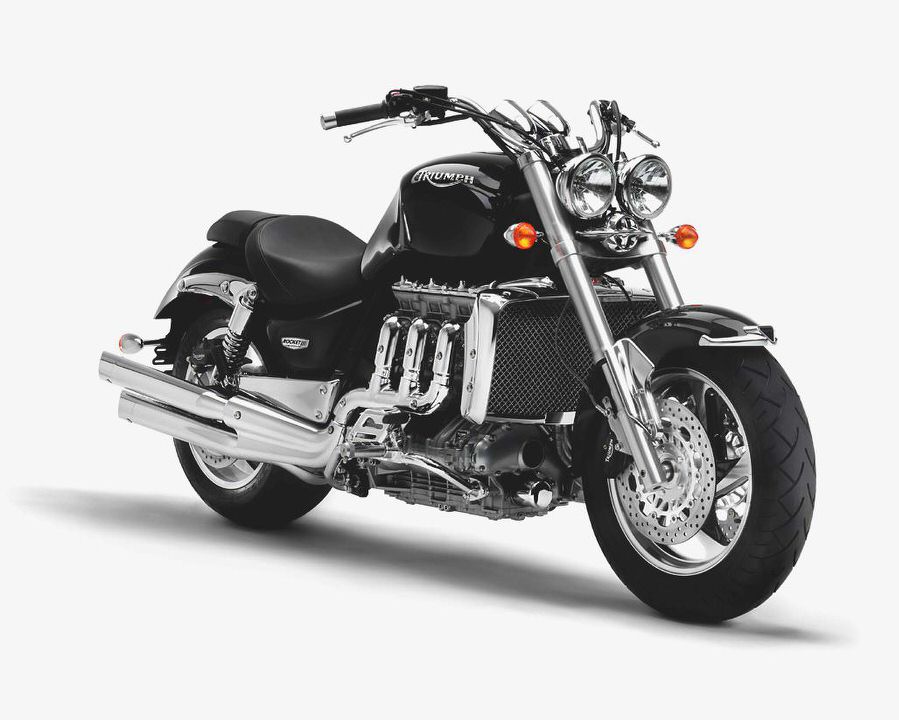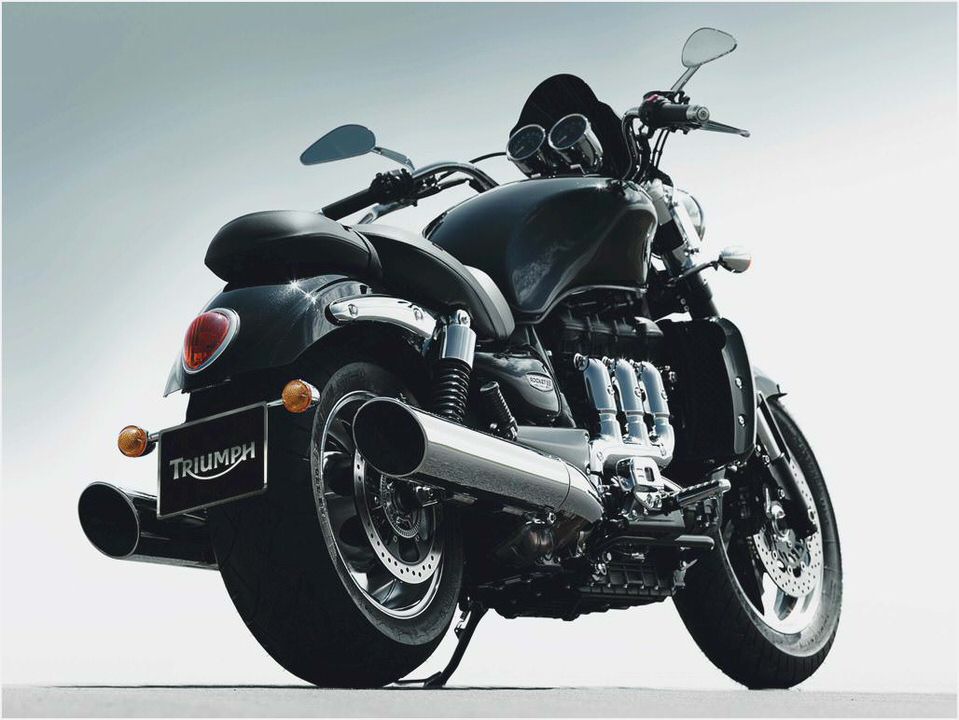
1012_hrbp_17_z+triumph_rocket_iii_touring+duel_leather_seats.jpg
Power is something riders always seem to be looking for more of. But touring bikes don’t need outright high-revving horsepower like a Japanese or Italian superbike, which can make upwards of 170 hp at the rear wheel. No, touring bikes are all about torque-that lazy power-in-any-gear feeling of rolling on the throttle and acceleration being right there for you.
This lust for torque was answered several years ago as manufacturers started bringing out bigger and bigger engined cruisers, even conservative Harley-Davidson got into the mix with its 110ci CVO models. The Triumph Rocket III (RIII) is the bike that ended the race.
At three cylinders and 2,300cc, it crossed lines that nobody wanted to touch. In the last couple of years, that lust for bigger and bigger engines had waned and models sat untouched and unwanted on dealer floors. Quite a few of them were discontinued, while others have been discounted down to the price of lesser machines. In the midst of all of this, Triumph released a second version of the Rocket III, called the Rocket III Touring.
We tested it when it came out back at the end of ’07 (Baggers, Mar. 2008), but never had a chance to do a real test, until now.
A dark little secret of the motorcycle industry is that most test rides are in the neighborhood of a few hundred miles, with some clocking in at under 150. On most touring bikes that’s not even a tank of gas. But, we do things differently here.
We thought we’d do one better for this big-boned behemoth and rode it almost the length of US 101, from L.A. to Seattle and back with lots of back roads to go with interminable miles of Interstate for a total of more than 3,300 on the clock from start to finish.
The original Rocket III that the Rocket III Touring is based on is no longer with us. It’s been replaced by more focused models like the Touring and the new Rocket III Roadster. Compared to the original RIII, the Touring got a skinnier (but not skinny) 180-section rear tire, and a motor tuned for smoother power delivery.
Delivery is key on this bike, with as much as it weighs (we think the claimed wet weight of 869 pounds might be a bit light), and as much power as it has, you wouldn’t want to have to gather it up after a moment or have to pick it up after a tip-over, as the thing is huge.
Obviously, it also comes with a package of touring goods akin to Harley’s Road King with a mid-size shield, hard bags, and floorboards all around. We tested an ’09 RIII Touring but the only difference to the 2010 model is that it now comes with more stuff. Ours was partially upgraded to current specs with a leather touring seat and backrests for rider (adjustable) and passenger.
The current model also comes with stylish mirrors, trim rails on the bags, a highway bar (with highway pegs), a luggage rack, passing lamps, and a taller windshield.
So why, you might ask, would anyone want a bike that weighs roughly what an Electra Glide does with far less luggage capacity? The answer is simple: power with total overkill in the torque department. Triumph claims this bike has 150 lb-ft at the rear wheel, while only cranking out just more than 100 horsepower.
In practical terms, this means that the smooth shifting gearbox is a luxury, as the motor will pull top gear at 25 mph, and accelerate briskly from 35 mph. This bike requires only two or three gears, not five, but having five means that you can really get up to speed very, very quickly. As I mentioned before, the RIII Touring has been retuned from the original spec Rocket, which is a very good thing.
The RIII can be a bit of a handful and you have to be very mindful of applying the throttle on it or the shaft drive can screw up your line in a corner. The Touring version is more of a pussycat; twisting the throttle uncorks an endless, but very controllable, stream of torque.
Handling is a mixed bag. It’s tight and predictable, but it feels its size. It’s one of those bikes that doesn’t want to stay leaned over without constant handlebar input.
When we first picked it up, this trait was overwhelming, but over the course of the test we fiddled with air pressure in the tires and found that it likes to be run near max pressure, which lightens up handling and helps it rail through corners.
Braking action is almost too good. We accidentally locked up both tires (not at the same time) more than once. The rear is very strong, especially on this bike that seems to have a front weight bias.
The new Rocket III Roadster has ABS, and we’re thinking it might be a nice addition for the Touring as well. Just to be clear, I’d rather have the power and learn to use it than have weak brakes and not have a chance in a real emergency. But then, I probably don’t need to tell you that any Rocket is not a beginner’s bike.
Actually should the need arise, this is one of those machines that it’s a better idea to avoid obstacles with the throttle. Not only does it have power to spare, it also doesn’t get out of shape when wrestling it around to avoid stray cars. On more than one occasion I dodged an inattentive motorist that invaded my lane and the RIIIT was the face of composure.
Given its name and size, as you might surmise, the Rocket is a hell of a ride on the superslab. Freeway cruising is its forte, as its neutral ergonomics, endless power, and luxurious leather saddle make the journey fun. There are few bikes, regardless of expense, that you can so effortlessly pick your spot in traffic and accelerate to it without any downshifting or wind-up. Avoiding the deaf, dumb, and blind was never so easy.
Triple-digit speed is just as easy, so it’s best to keep a vigilant watch on the speedo and your right wrist in check. The bike does what it can to help you out with that, with apparently massive springs on the massive throttle bodies that power this beast-the throttle pull is brutal, and there is no cruise control. The bars are rubber-mounted and sport huge bar-end weights to cut down on vibration.
This works very well, but there is about an inch of front-to-back movement at the bar, which feels weird in parking lot maneuvering. Vibration starts to creep into the bars at about 80 mph, which is good because it alerts you when you’re beyond the speed limit.
The low windshield on our test unit was about perfect for a 6-foot rider, and I, for one, wouldn’t like the taller shield that comes stock on the 2010 version. The adjustable backrest, which is standard on the 2010, was very nice, and very easy to adjust with a thumbwheel behind the mount. Since the backrest is attached to the seat, not the frame, it’s easy to pull the seat and get to the battery underneath.

Mileage and range are on the low side for a touring bike, and can vary wildly. On back roads (or just taking it easy) it can get up to 40 mpg, but stop and go or flat out bombing can see mileage dip well below 30 mpg.
Back roads are also pretty good on the RIIIT. It’s nice to be able to pick a gear and pretty much never shift unless you want to. She’s a big girl and needs to be pushed around forcefully in and out of corners, but unless the easily adjustable suspension is bottomed, it never gets squirrelly.
Lazy, sweeping back roads are best, as they require the least effort to stay between the lines.
Getting on the gas between corners or accelerating to highway speed, the exhaust has a decent growl, but it’s no V-twin. In fact at idle it sounds a little nautical, like a boat. The shaft-driven triple pulls to the right at a stop if the throttle is blipped, but not while moving, thanks to a counter-rotating driveshaft.
The back end does rise a bit on the gas, but it’s nothing we didn’t get used to.
Storage from the saddlebags is decent, but like most bags that aren’t Harleys, the latching system eats up some real estate and gets in the way if you’re attempting to overstuff the bags. The push-button latches tended to stick and didn’t always latch the first time, but the locking mechanism was perfect. The pockets built into the outside wall were a nice touch holding the manual and tool kit, and had enough room left over for additional tools or any small objects you don’t want to lose.
While our tester didn’t have the luggage rack now standard on the bike, we loaded it down like it had one anyhow, using a tent to protect the fender from our oversized sissybar bag.
We’ll let you make up your own mind on the styling-it’s big and projects a big image. The first thing most civilians commented on when we rolled up is the large automotive-looking radiator hanging in front of a large automotive-looking engine. Beyond the big motor compartment, fuel tank, and chrome intake scoop on the left side, styling is pretty conventional without big swooping fenders or over-styled bags.
The 25-spoke cast wheels give the illusion of spoked rims, but without the weight or the hassle of tube-style tires.
If you’re looking for what you can do with it on the custom side (this is Baggers, after all), we’ll have a feature in the coming months of one done up by a major audio store chain complete with top box, fairing, and big-ass stereo system; big sound to go with that big power.
If you want details on the 3,300-mile trek I took, that will have to wait for upcoming issues of Baggers, as I’m putting together a three-part story of a fun, inexpensive trip that is not what you’re used to seeing in magazines. One thing is for sure: this is a bike that grew on me. I wasn’t all that thrilled with it out of the gate, but knocking down some 400-600 mile days (on back roads, while taking pictures), and never getting off the bike in pain, was pretty nice.
With cruise control and ABS, it would be everything a power junkie could ever want.
- 2010 Triumph Rocket III Roadster Review- Triumph Rocket III Riding Reviews
- RideApart Review: Triumph Bonneville SE RideApart
- 2009 Triumph Street Triple
- 2005 Triumph Bonneville America
- Triumph Sprint ST Reviews in motorbikes & Tourers at Review Centre

